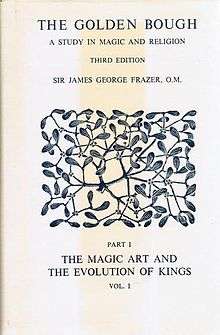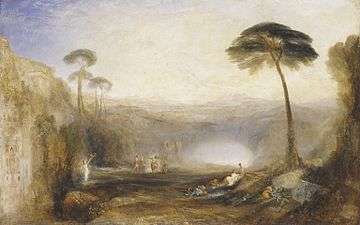The Golden Bough
 The 1926 Macmillan Press edition | |
| Author | James George Frazer |
|---|---|
| Country | United Kingdom |
| Language | English |
Publication date | 1890 |
The Golden Bough: A Study in Comparative Religion (retitled The Golden Bough: A Study in Magic and Religion in its second edition) is a wide-ranging, comparative study of mythology and religion, written by the Scottish anthropologist Sir James George Frazer (1854–1941). It was first published in two volumes in 1890; in three volumes in 1900; the third edition, published 1906–15, comprised twelve volumes. The work was aimed at a wide literate audience raised on tales as told in such publications as Thomas Bulfinch's The Age of Fable, or Stories of Gods and Heroes (1855). The influence of The Golden Bough on contemporary European literature and thought was substantial.[1]
Subject matter


The Golden Bough attempts to define the shared elements of religious belief and scientific thought, discussing fertility rites, human sacrifice, the dying god, the scapegoat and many other symbols and practices whose influence has extended into twentieth-century culture.[2] Its thesis is that old religions were fertility cults that revolved around the worship and periodic sacrifice of a sacred king. Frazer proposed that mankind progresses from magic through religious belief to scientific thought.[3]
This thesis was developed in relation to J. M. W. Turner's painting of The Golden Bough, a sacred grove where a certain tree grew day and night. It was a transfigured landscape in a dream-like vision of the woodland lake of Nemi, "Diana's Mirror", where religious ceremonies and the "fulfillment of vows" of priests and kings were held.[4]
The king was the incarnation of a dying and reviving god, a solar deity who underwent a mystic marriage to a goddess of the Earth. He died at the harvest and was reincarnated in the spring. Frazer claims that this legend of rebirth is central to almost all of the world's mythologies.
Frazer based his thesis on the pre-Roman priest-king at the fane of Nemi, who was ritually murdered by his successor:
When I first put pen to paper to write The Golden Bough I had no conception of the magnitude of the voyage on which I was embarking; I thought only to explain a single rule of an ancient Italian priesthood. (Aftermath, p. vi)
The book's title was taken from an incident in the Aeneid, illustrated by Turner: Aeneas and the Sibyl present the golden bough to the gatekeeper of Hades to gain admission.
Reception
The book scandalized the British public when first published, as it included the Christian story of Jesus and the Resurrection in its comparative study. Critics thought this treatment invited an agnostic reading of the Lamb of God as a relic of a pagan religion. For the third edition, Frazer placed his analysis of the Crucifixion in a speculative appendix; the discussion of Christianity was excluded from the single-volume abridged edition.[5][6]
The book's influence on the emerging discipline of anthropology was pervasive and undeniable. For example, Bronisław Malinowski, stricken with tuberculosis shortly after receiving his doctorate in physics and mathematics, read Frazer's work in the original English to distract himself from his illness.
No sooner had I read this great work than I became immersed in it and enslaved by it. I realized then that anthropology, as presented by Sir James Frazer, is a great science, worthy of as much devotion as any of her elder and more exact studies and I became bound to the service of Frazerian anthropology.[7]
Despite the controversy the work generated, and its critical reception amongst other scholars, The Golden Bough inspired the creative literature of the period. The poet Robert Graves adapted Frazer's concept of the dying king sacrificed for the good of the kingdom to the romantic idea of the poet's suffering for the sake of his Muse-Goddess, as reflected in his book on poetry, rituals and myths The White Goddess (1948). William Butler Yeats refers to Frazer's thesis in his poem "Sailing to Byzantium". H. P. Lovecraft mentions the book in his short story "The Call of Cthulhu". T. S. Eliot acknowledged indebtedness to Frazer in his first note to his poem The Waste Land. William Carlos Williams refers to it in Book Two, part two, of his extended poem in five books Paterson. Sigmund Freud, James Joyce, Ernest Hemingway, D. H. Lawrence, Aleister Crowley, Ezra Pound, William Gaddis, Mary Renault, Joseph Campbell, Roger Zelazny, Jim Morrison (in "Celebration of the Lizard", specifically "Not to Touch the Earth"), Naomi Mitchison (in her The Corn King and the Spring Queen) and Camille Paglia,[8] are some of the authors whose work shows the deep influence of The Golden Bough. Its literary ripples and references have given it continued life, even as its direct influence in anthropology has waned.
Critical analysis
The philosopher Ludwig Wittgenstein returned time and time again to The Golden Bough, so much so that his commentaries have been compiled as Remarks on Frazer's Golden Bough, edited by Rush Rhees, originally published in 1967 (the English edition followed in 1971).[9] He writes, "Frazer is much more savage than most of these savages."[10] Weston LaBarre observed that Frazer was "the last of the scholastics" and wrote The Golden Bough "as an extended footnote to a line in Virgil he felt he did not understand."[11]
Some modern critics set Frazer in the broader context of the history of ideas, for example, Robert Ackerman in his The Myth and Ritual School: J. G. Frazer and the Cambridge Ritualists. The myth and ritual school includes scholars Jane Harrison, Gilbert Murray, F. M. Cornford, and A.B. Cook, who were connecting the new discipline of myth theory and anthropology with traditional literary classics at the end of the nineteenth century. This school was an important influence on much Modernist literature.
Publishing history
Editions
- First edition, 2 vols., 1890. (Vol. I, II)
- Second edition, 3 vols., 1900. (Vol. I, II, III)
- Third edition, 12 vols., 1906-15.
- Volume 1 (1906): The Magic Art and the Evolution of Kings (Part 1) 1920 (reprint)
- Volume 2 (1911): The Magic Art and the Evolution of Kings (Part 2)
- Volume 3 (1911): Taboo and the Perils of the Soul
- Volume 4 (1911): The Dying God
- Volume 5 (1914): Adonis, Attis, Osiris (Part 1)
- Volume 6 (1914): Adonis, Attis, Osiris (Part 2)
- Volume 7 (1912): Spirits of the Corn and of the Wild (Part 1)
- Volume 8 (1912): Spirits of the Corn and of the Wild (Part 2)
- Volume 9 (1913): The Scapegoat
- Volume 10 (1913): Balder the Beautiful (Part 1)
- Volume 11 (1913): Balder the Beautiful (Part 2)
- Volume 12 (1915): Bibliography and General Index
Supplement
1937 edition: Aftermath: A Supplement to the Golden Bough
Abridged editions
- Abridged edition, 1 vol., 1922. This edition excludes Frazer's references to Christianity.
- 1995 Touchstone edition, ISBN 0-684-82630-5
- 2002 Dover reprint of 1922 edition, ISBN 0-486-42492-8
- Abridged edition, edited by Theodor H. Gaster, 1959, entitled The New Golden Bough: A New Abridgment of the Classic Work.
- Abridged edition, edited by Robert Fraser for Oxford University Press, 1994. It restores the material on Christianity purged in the first abridgement. ISBN 0-19-282934-3
Online text
The 1922 edition of The Golden Bough on the Internet Sacred Text Archive
See also
- Archetypal literary criticism
- Force-fire
- Not to Touch the Earth
- Rex Nemorensis
- Seclusion of girls at puberty
- The Hero with a Thousand Faces
- The Mass of Saint-Secaire
- The Golden Bough (mythology)
- Totem and Taboo
References
Citations
- ↑ Karbiener, K. and Stade, G., Encyclopedia of British Writers, 1800 to the Present, Volume 2, Infobase Publishing, 2009, pp. 188–190.
- ↑ Hamel, Frazer, ed. The Golden Bough, London: Wordsworth, 1993.
- ↑ Hamel, Frazer, ed. The Golden Bough, London: Wordsworth, 1993.
- ↑ Frazer, Sir James. The Golden Bough, London: Wordsworth, 1993.
- ↑ Leach, Edmund R."Kingship and divinity: The unpublished Frazer Lecture, Oxford, 28 October 1982." HAU: Journal of Ethnographic Theory 1.1 (2011): 279-298.
- ↑ Smith, Jonathan Z. "When the bough breaks." History of Religions 12.4 (1973): 342-371.
- ↑ Hays, From Ape to Angel: An Informal History of Social Anthropology, p. 314, cited in L. L. Langness, The Study of Culture (Corte Madera: Chandler & Sharp, 1974), p. 75
- ↑ Paglia, Camille (1993). Sex, Art, and American Culture: Essays. London: Penguin Books. p. 114. ISBN 0-14-017209-2.
- ↑ Phil.uni-passau.de
- ↑ Wittgenstein, Ludwig, Remarks on Frazer's Golden Bough, p. 131
- ↑ The Human Animal (Chicago, 1954), cited in Langness, The Study of Culture, pp. 24f
Further reading
- Ackerman, Robert. The Myth and Ritual School: J. G. Frazer and the Cambridge Ritualists (Theorists of Myth) 2002. ISBN 0-415-93963-1.
- Bitting, Mary Margaret. The Golden Bough: An Arrangement of Sir James George Frazer's The Golden Bough in Play Form (Vantage Press, 1987). ISBN 0-533-07040-6
- Csapo, Eric. Theories of Mythology (Blackwell Publishing, 2005), pp 36–43, 44–67. ISBN 978-0-631-23248-3.
- Fraser, Robert. The Making of The Golden Bough: The Origins and Growth of an Argument (Macmillan, 1990; re-issued Palgrave 2001).
- Smith, Jonathan Z. "When the Bough Breaks," in Map is not territory, pp 208–239 (The University of Chicago Press, 1978).
External links
| Wikisource has original text related to this article: |
Text copies of the 1922 edition:
- The Golden Bough at Project Gutenberg
- HTML version of The Golden Bough on the Internet Sacred Text Archive
 The Golden Bough public domain audiobook at LibriVox
The Golden Bough public domain audiobook at LibriVox- The Golden Bough on eBooks@Adelaide